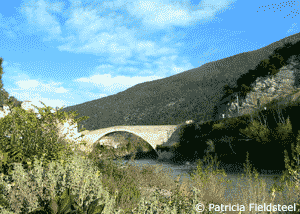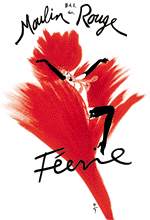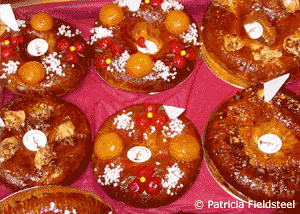January in Provence

- SUBSCRIBE
- ALREADY SUBSCRIBED?
BECOME A BONJOUR PARIS MEMBER
Gain full access to our collection of over 5,000 articles and bring the City of Light into your life. Just 60 USD per year.
Find out why you should become a member here.
Sign in
Fill in your credentials below.
Nyons, France. The Parisians who spend the holidays in their vacation houses have left, the tourists have gone, and les gosses have returned to school. The feasting and fêtes are mercifully done with. There can be too much of a good thing–the remaining foie gras in my frigo went into the poubelle, after I gave each of the animals a small piece. Daily routine? I’m basking in its luxury! But more than that, I just love Provence in deepest, dullest winter. Perhaps this time of year holds such sweetness for me because my first experience living in Provence began in January.
 Provence in January? Seriously, it’s lovely. Calm, peaceful, serene. I tell myself this is the real Provence, the Provence for people who actually live here. This Provence is just for us, our time to luxuriate chez nous. Mornings, smoke rises from the chimneys on the ancient rooftops like the tail of a happy cat, the air blossoming with the bouquet of crackling wood. I lie in bed and watch the day emerge from night. The first awakening begins across the river, shortly before 8:00, behind the mountains and rocks. It starts with a slight lightening above the mountaintops, then spills across the sky in palest blue. Wisps of cloud emerge pink and soft like the silk slips from my grandmother’s trousseau, and then the sun, bursting, enormous, blinding bright. Another winter day in Provence has begun. In an hour or so the temperature will climb to the mid-50s, the outdoor cafés will begin to fill and the sitters will follow the sun as it crosses the Place de la Libération and they move from La Belle Époque, Kiosque and Palmiers in the morning to the Cafés de la Tour, Autostop, Pontias and La France in the afternoon. Often, the main topic of conversation will be the frigid temperature and the degree (no pun intended) to which everyone is suffering. Bitter cold to the Nyonsais is anything below 50 degrees Fahrenheit. Occasionally, I am unable to restrain myself from blurting out, “You don’t know from cold,” but I try to respect local sensibilities and customs. When the nightly news carries sensational reports about a deadly chill in New York, my neighbors are incredulous that any human being–especially one with whom they are personally acquainted–could survive such conditions. I admit to a certain delight in dismissing it all with a Gallic flourish of my hand, “C’est normale pour New York,” as they step back in awe, shudder and
Provence in January? Seriously, it’s lovely. Calm, peaceful, serene. I tell myself this is the real Provence, the Provence for people who actually live here. This Provence is just for us, our time to luxuriate chez nous. Mornings, smoke rises from the chimneys on the ancient rooftops like the tail of a happy cat, the air blossoming with the bouquet of crackling wood. I lie in bed and watch the day emerge from night. The first awakening begins across the river, shortly before 8:00, behind the mountains and rocks. It starts with a slight lightening above the mountaintops, then spills across the sky in palest blue. Wisps of cloud emerge pink and soft like the silk slips from my grandmother’s trousseau, and then the sun, bursting, enormous, blinding bright. Another winter day in Provence has begun. In an hour or so the temperature will climb to the mid-50s, the outdoor cafés will begin to fill and the sitters will follow the sun as it crosses the Place de la Libération and they move from La Belle Époque, Kiosque and Palmiers in the morning to the Cafés de la Tour, Autostop, Pontias and La France in the afternoon. Often, the main topic of conversation will be the frigid temperature and the degree (no pun intended) to which everyone is suffering. Bitter cold to the Nyonsais is anything below 50 degrees Fahrenheit. Occasionally, I am unable to restrain myself from blurting out, “You don’t know from cold,” but I try to respect local sensibilities and customs. When the nightly news carries sensational reports about a deadly chill in New York, my neighbors are incredulous that any human being–especially one with whom they are personally acquainted–could survive such conditions. I admit to a certain delight in dismissing it all with a Gallic flourish of my hand, “C’est normale pour New York,” as they step back in awe, shudder and  hurry home to their pots au feu, cassoulets and hearty soups bubbling contentedly on their stoves.
hurry home to their pots au feu, cassoulets and hearty soups bubbling contentedly on their stoves.
This is la France profonde, the real country, no haute cuisine–three lightly steamed pea pods and a swizzle of foam on a plate. Restaurants feature hearty game, stews, truffles, foie gras and lots of potatoes and pork. No self-respecting super- or hypermarché is without a massive January sale of porc–chops and ribs, cutlets and roasts, ears, snouts, feet, tails, organs, blood, whole heads and bodies. Glancing into some of the neighboring shopping chariots on the check-out line is not for those with delicate constitutions.
Winter is also hunting season and weekends are heavy with the pop-pop of buckshot from the hills. Sanglier (wild boar) is the regional specialty and everyone has an “encounter-with-a-sanglier” story to tell. I even have one of my own. Driving home one night on the twisting unlit road between Mirabel-les-Baronnies and Nyons, something enormous dashed in front of my car. Swerving, applying my brakes, I was just quick enough to avoid colliding with a mammoth sanglier. Colliding with a sanglier is akin to colliding with a rhinoceros; the car will not survive and often not the passengers inside it; the sanglier will trot away untouched.
This winter, for the first time, I did not work the olivade (olive harvest); I had to be in Germany when it took place. Nyons is the olive capital of France; its oil was the first to have an A.O.C., like the finest wines. Olives begin on the trees as delicate white flowers, then evolve into hard green fruit. Gradually they fatten to brown, then black; when they are wrinkled, it’s time to pick. Oliviers (olive trees) never shed their leaves. In winter, Nyons is blanketed by a lush velvet patchwork in shades of green from the oliviers, cyprès, pins d’Aleppe, palmiers and fir trees mixed with the tans and browns of the bare rocky earth and gnarled roots where the grape vines have been stripped, cut back and tied; their leaves and branches burn in small piles throughout the winter, leaving low-hanging strands of smoky clouds.
At night, Emily and I walk along the river in the moonlight. The songs of the frogs and cigales are silenced; the annoying swarms of gnats gone with the first frost. There is only the river, gurgling, swishing, glistening over the rocks, punctuated by the occasional conversation of ducks. There are seventeen year-round resident ducks who live beneath the Pont Roman, seven couples (ducks mate for life) and last spring three ducklings. An elderly Nyonsaise, dubbed Mlle. Canard, slowly makes her way every morning and afternoons after lunch from the local hospital where she lives to the arch of the bridge, where she spends her days talking to the ducks and tossing them morsels of bread from plastic sacs. These days she also tosses stale chunks of galettes and gâteaux des rois, the cakes of Epiphany, which are sold with their golden cardboard crowns in patisseries, boulangeries, epicéries and supermarkets from January 6th (Épiphanie or Twelfth Night, the Feast of the Magi) until February 2nd (Chandeleur or Candlemas), the end of the holidays and the traditional day to dismantle indoor crèches.
In Provence, the gâteaux of the Three Kings, are made of brioche dough, often scented with lemon zest or orange flower water, shaped in a ring resembling a crown and studded on top with glazed crystallized fruit meant to resemble precious jewels. In Paris, the galettes of the Magi are flat round disks made from mille feuille pastry stuffed with frangipane or hazelnut cream. Both versions have the golden cardboard crown, to be worn by the person who finds the fève in her or his slice. And what is the fève? Initially it really was a dried bean. Why a dry fava bean in the middle of a sweet cake? Legends and historical accounts abound. Some point back to the ancient Romans who used white and black beans for voting in elections and chose the King of their early January Saturnalia festival with a bean.(Remember, much of France was once part of the Roman Empire.) The bean is also a symbol of fertility and renewal, celebrated at the new year. Naturally, all self-respecting Français trace the fève’s origins back to France, usually to the 13th-Century monks of Besançon (near Dijon) who chose their leader at Epiphany by putting a gold coin in a loaf of bread, the winner being the one whose piece held the coin, which was then set aside for the poor. Under Louis the 14th, the Church decided the Epiphany celebration was pagan and banned it, calling it an excuse for unnecessary indulgence. The crafty citizens got around the ban by calling the day “La Fête du Bon Voisinage” and used the cakes to share with neighbors as a sign of good will.
During the Revolution, when kings slightly fell into disfavor, the cake was briefly renamed “Gâteau d’Égalité.” (Freedom fries, anyone?) Up until the 19th Century, a fava bean was placed inside and the person whose piece held the bean was named King (or Queen), given the paper crown and was expected to pay for a round of drinks or more cakes for all the guests. Consequently, (the French being noted for thrift) many people swallowed the bean. In 1877, Gottschalk, a German importer of porcelain toys on the Rue Faubourg Saint-Martin in Paris, started to make tiny porcelain figures to put in the cakes. The practice quickly caught on and ever since, fèves (which are never more than 1.04 inches in size) have become highly treasured and collectible items, with some selling for hundreds of euros apiece. From 1900-1914, Limoges became the capital of fève creation and manufacture in what is referred to by fabophiles (fève collectors) as the “Golden Age of Fèves.” During the 1950s, the production of plastic fèves began, “a low point,” redeemed in the 1960s when “la fève retrouve sa noblesse” with the introduction in Provence of small faïence santon fèves. Fèves not found inside cakes, are sold in sets of either six or twelve and are grouped around a theme–ranging from Harry Potter, the Simpsons, Asterix, Babar and Lord of the Rings to cats, dogs, old cars, Kings and Queens, writers, philosophers, flowers and plants, household utensils, articles of clothing, Nativity figures, saints, Popes, nautical instruments,
positions from the Kama Sutra, musical instruments and shoes. In other
words, everything. Go to any brocante and you will find them for sale by the hundreds. There are societies and clubs; a group of collectors meets regularly in nearby Vaison-la-Romaine; there’s even a museum with over 10,000 fèves in Blain (near Nantes). On March 20th, L’Association des Fabophiles Français will hold their 28th Annual Salon in Paris, at 22, rue André Antoine in the 18ième, open to the public for a small fee. Either you’re a bean counter/collector, or you’re not.
Last week, I was invited to a Sunday afternoon Tireurs des Rois party  with a promised large spread of gâteaux and galettes des Rois and local Beaumes-de-Venise, a sweet muscat. The day was exquisitely sunny and warm, too nice to be inside. I politely declined and went with Emily, my Westie, to the Sunday brocante in Carpentras, where I found all sorts of treasures I don’t need. We had a glorious afternoon. Instead of Gâteau des Rois, we shared a small chèvre, crème fraiche and lardon pizza. A typical January Sunday, living in Provence.
with a promised large spread of gâteaux and galettes des Rois and local Beaumes-de-Venise, a sweet muscat. The day was exquisitely sunny and warm, too nice to be inside. I politely declined and went with Emily, my Westie, to the Sunday brocante in Carpentras, where I found all sorts of treasures I don’t need. We had a glorious afternoon. Instead of Gâteau des Rois, we shared a small chèvre, crème fraiche and lardon pizza. A typical January Sunday, living in Provence.


